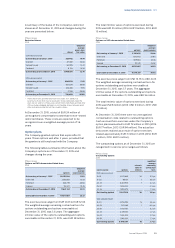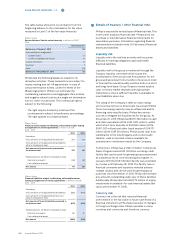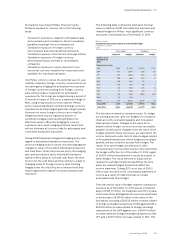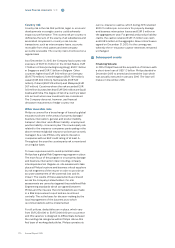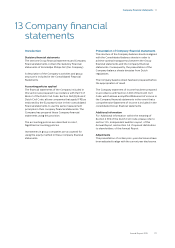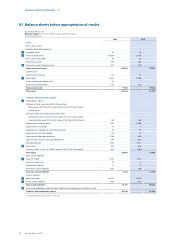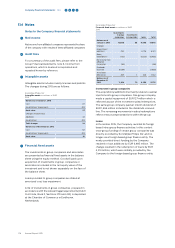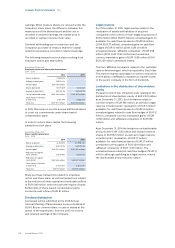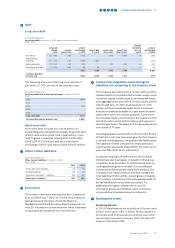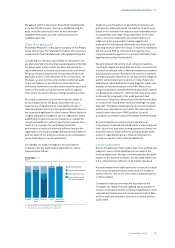Philips 2015 Annual Report Download - page 169
Download and view the complete annual report
Please find page 169 of the 2015 Philips annual report below. You can navigate through the pages in the report by either clicking on the pages listed below, or by using the keyword search tool below to find specific information within the annual report.
Group nancial statements 12.9
Annual Report 2015 169
expense would increase by approximately EUR 1
million. This impact was based on the outstanding net
cash position at December 31, 2015.
A sensitivity analysis conducted as of January 2015
shows that if long-term interest rates were to decrease
instantaneously by 1% from their level of December 31,
2014, with all other variables (including foreign
exchange rates) held constant, the fair value of the
long-term debt would increase by approximately EUR
342 million. If there was an increase of 1% in long-term
interest rates, this would reduce the market value of the
long-term debt by approximately EUR 341 million.
If interest rates were to increase instantaneously by 1%
from their level of December 31, 2014, with all other
variables held constant, the annualized net interest
expense would decrease by approximately EUR 13
million. This impact was based on the outstanding net
cash position at December 31, 2014.
Equity price risk
Equity price risk is the risk that the fair value or future
cash ows of a nancial instrument will uctuate
because of changes in equity prices.
Philips is a shareholder in some publicly listed
companies, including Corindus Vascular Robotics. As a
result, Philips is exposed to potential nancial loss
through movements in their share prices. The aggregate
equity price exposure in such nancial assets
amounted to approximately EUR 75 million at year-end
2015 (2014: EUR 12 million). Philips does not hold
derivatives in its own shares or in the above mentioned
listed companies. Philips is also a shareholder in several
privately-owned companies amounting to EUR 48
million. As a result, Philips is exposed to potential value
adjustments.
Commodity price risk
Commodity price risk is the risk that the fair value or
future cash ows of a nancial instrument will uctuate
because of changes in commodity prices.
Philips is a purchaser of certain base metals, precious
metals and energy. Philips hedges certain commodity
price risks using derivative instruments to minimize
signicant, unanticipated earnings uctuations caused
by commodity price volatility. The commodity price
derivatives that Philips enters into are accounted for as
cash ow hedges to oset forecasted purchases. As of
December 2015, a loss of EUR 0.2 million was deferred
in equity as a result of these hedges. A 10% increase in
the market price of all commodities as of December 31,
2015 would increase the fair value of the derivatives by
less than EUR 0.1 million.
As of December 2014, a loss of EUR 0.7 million was
deferred in equity as a result of these hedges. A 10%
increase in the market price of all commodities as of
December 31, 2014 would increase the fair value of the
derivatives by EUR 0.7 million.
Credit risk
Credit risk represents the loss that would be recognized
at the reporting date, if counterparties failed
completely to perform their payment obligations as
contracted. Credit risk is present within Philips trade
receivables. To have better insights into the credit
exposures, Philips performs ongoing evaluations of the
nancial and non-nancial condition of its customers
and adjusts credit limits when appropriate. In instances
where the creditworthiness of a customer is determined
not to be sucient to grant the credit limit required,
there are a number of mitigation tools that can be
utilized to close the gap including reducing payment
terms, cash on delivery, pre-payments and pledges on
assets.
Philips invests available cash and cash equivalents with
various nancial institutions and is exposed to credit
risk with these counterparties. Philips is also exposed
to credit risks in the event of non-performance by
nancial institutions with respect to nancial derivative
instruments. Philips actively manages concentration
risk and on a daily basis measures the potential loss
under certain stress scenarios, should a nancial
institution default. These worst-case scenario losses
are monitored and limited by the Company.
The Company does not enter into any nancial
derivative instruments to protect against default by
nancial institutions. However, where possible the
Company requires all nancial institutions with whom it
deals in derivative transactions to complete legally
enforceable netting agreements under an International
Swap Dealers Association master agreement or
otherwise prior to trading, and whenever possible, to
have a strong credit rating from Standard & Poor’s and
Moody’s Investor Services. Philips also regularly
monitors the development of the credit risk of its
nancial counterparties. Wherever possible, cash is
invested and nancial transactions are concluded with
nancial institutions with strong credit ratings or with
governments or government-backed institutions.
Below table shows the credit ratings of the nancial
institutions with which Philips had short-term deposits
above EUR 25 million as of December 31, 2015:
Philips Group
Credit risk with number of counterparties
for deposits above EUR 25 million
2015
25-100 million 100-500 million
AA-rated bank
counterparties 2
A-rated bank
counterparties 4 2
4 4
For an overview of the overall maximum credit
exposure of the group’s nancial assets, please refer to
note 30, Fair value of nancial assets and liabilities for
details of carrying amounts and fair value.


